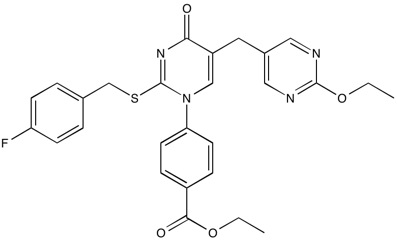GW1100 | GPR40 antagonist
NMR (Conforms)

Available Options
| Size : | Price | Quantity | |
|---|---|---|---|
| 5 mg | $55.00 | ||
| 25 mg | $180.00 |
GW1100 (306974-70-9) is a selective antagonist of GPR40. GW1100 inhibits GRP40-mediated Ca2+ increases stimulated by GW9508 (Cat.# 10-1108) or linoleic acid (pIC50 = 5.99 for either agonist).1 The effects of GPR40 activation on insulin secretion in cells are also blocked by the addition of GW1100. GW1100 does not influence calcium mobilization mediated by GPR120.
References/Citations:
1) Brisco et al. (2006), Pharmacological regulation of insulin secretion in MIN6 cells through fatty acid receptor GPR40: identification of agonist and antagonist molecules; Br. J. Pharmacol., 148 619
2) Nagatake et al. (2018), The 17,18-Epoxytetraenoic acid-G protein-coupled receptor 40 axis ameliorates contact hypersensitivity by inhibiting neutrophil mobility in mice and cynomolgus macaques; J. Allergy Clin. Immunol., 142 470 [Focus Biomolecules Citation]
NMR (Conforms)
Safety Data Sheet:
Product Data Sheet:
Materials provided by Focus Biomolecules are for laboratory research use only and are not intended for human or veterinary applications. Please note that we do not sell to individuals and that all orders placed by non-research organizations will incur a $20 restocking/refund fee
GW1100 (306974-70-9) is a selective antagonist of GPR40. GW1100 inhibits GRP40-mediated Ca2+ increases stimulated by GW9508 (Cat.# 10-1108) or linoleic acid (pIC50 = 5.99 for either agonist).1 The effects of GPR40 activation on insulin secretion in cells are also blocked by the addition of GW1100. GW1100 does not influence calcium mobilization mediated by GPR120.
References/Citations:
1) Brisco et al. (2006), Pharmacological regulation of insulin secretion in MIN6 cells through fatty acid receptor GPR40: identification of agonist and antagonist molecules; Br. J. Pharmacol., 148 619
2) Nagatake et al. (2018), The 17,18-Epoxytetraenoic acid-G protein-coupled receptor 40 axis ameliorates contact hypersensitivity by inhibiting neutrophil mobility in mice and cynomolgus macaques; J. Allergy Clin. Immunol., 142 470 [Focus Biomolecules Citation]
Related Orphan GPCR Ligands
Download
Calculate the molar concentration, mass or volume in a solution.
Concentration × Volume × Molecular Weight = Mass
Focus Biomolecules • Plymouth Meeting, PA USA • 1-855-FOCUS21
Focus Biomolecules
Plymouth Meeting, PA USA
1-855-FOCUS21
Website Created by Advanta Advertising LLC.

